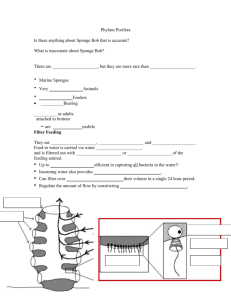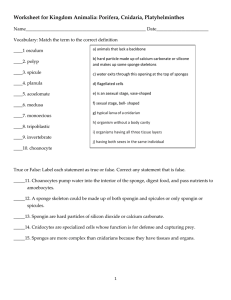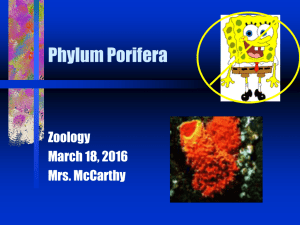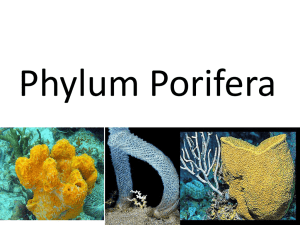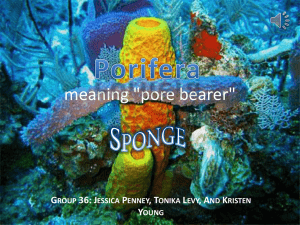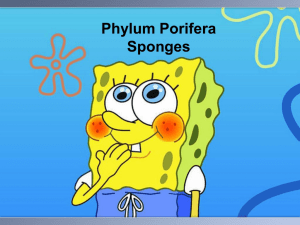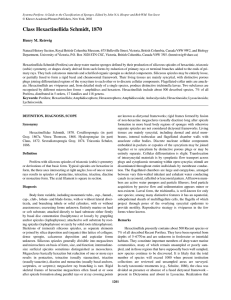Marine Invertebrates
advertisement
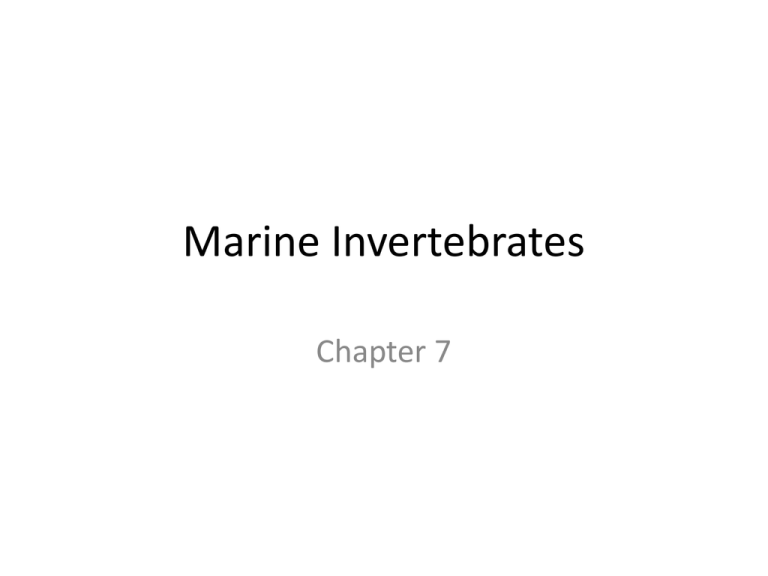
Marine Invertebrates Chapter 7 The Classification of Organisms Prokaryotes Eukaryotes Kingdom Animalia Kingdom Protista Domain Bacteria Domain Archaea Kingdom Fungi Kingdom Plantae Domain Eukarya Animal Kingdom • Characteristics of Animals: – Eukaryotic – Multicellular – Heterotrophic – Reproduce sexually – Contain cells lacking a cell wall – Usually capable of movement at some stage in life Major Phyla of the Animal Kingdom Phylum Examples Porifera Sponges Cnidaria Jellyfish, sea anemones, corals Ctenophora Comb jellies Platyhelmenthes Flukes, tapeworms Nematoda Roundworms Annelida Polychaetes, leeches Mollusca Snails, clams, oysters, octopus, squid Arthropoda Crustaceans Echinodermata Sea stars, sea urchins Chordata vertebrates Phylum Porifera • • • • • • • • Structurally simplest animal Do not form true tissues or organs Mostly sessile – living attached to a surface Variety of shapes, sizes, and colors Simple body plan Filter feed on plankton Reproduce sexually by broadcast spawning Some reproduce asexually when buds break off Sponge Anatomy http://www.mun.ca/biology/scarr/Porifera.htm Sponge Anatomy Sponge Anatomy Structure Function Pinacocyte Flat cells covering the outer structure Pore cells or porocytes Tube-like cells that allow water to enter Structure Function Choanocytes (or collar cells) Cells lining the larger feeding chamber of the sponge; contains a thin flagellum to create a current and collar to trap food particles Oculum Large opening on the top of the sponge through which water exits the sponge Structure Function Spicules Used for structural support; transparent siliceous or calcareous structures of different shapes and sizes (http://etc.usf.edu/clipart/47800/47878/47878_spo_spicules.htm) Structure Function Spongin Tough, elastic fibers to help support the sponge Can be sole means of support or found with spicules (http://www.palaeos.com/Invertebrates/Lists/Images/Spongin.jpg Amebocytes ) Wandering cells Secrete the spicules and spongin Can transport and store food particles Some can transform themselves into other types of cells Sponge Feeding • Suspensions feeders – animals that eat food particles suspended in the water – Specifically, sponges are filter feeders, suspension feeders that actively filter the food particles http://www.mesa.edu.au/friends/seashores/sponges1.html Sponge filtering - http://www.youtube.com/watch?v=T7E1rq7zHLc Sponge filtering http://www.youtube.com/watch?v=T7E1rq7zHLc Sponge Reproduction • Asexual (one parent) – when branches or buds break off, they will grow into separate sponges identical to the parent • Sexual (two parents) – sponges produce sex cells, gametes, nutrient rich eggs and sperm with flagellum – Broadcast spawning Body Plans • Sponges have three basic body plans: – Asconoid – Syconoid – Leuconoid Asconoid • Simplest form • A simple tube perforated by holes • Central cavity, spongocoel, lined with choanocytes http://animaldiversity.ummz.umich.edu/site/resources/klaus_jost/00017869.jpg/view.html Syconoid • Large tubular body with a single osculum • Thicker body wall than asconoid • Longer pores that that form simple canals • Canals lined with choanocytes (not central spongocoel) http://animaldiversity.ummz.umich.edu/site/resources/Grzimek_inverts/Hexactinellida/Euplectella_aspergillum.jpg/view.html http://eastchestereagles.wikispaces.com/Animal+Phyla+Even+Porifera Leuconoid • Most complex body plan • Vast network of interconnecting canals that eventually lead to one or numerous larger oscula <http://animaldiversity.ummz.umich.edu/site/resources/klaus_jost/00000222.jpg/view.html> http://eastchestereagles.wikispaces.com/Animal+Phyla+Even+Porifera Classes of Porifera • Three classes of Porifera: – Calcarea – Hexactinellida – Demospongiae Classes of Porifera • Class Calcarea – includes sponges with all three body plans – produce large spicules (megascleres) of calcium carbonate. • Classes Hexactinellida – only possess leuconoid members – produce six-pointed large and small spicules (megaand microcleres) made of silica. • Class Demospongiae – only possess leuconoid members – may have microscleres and megascleres, spongin, both, or neither

